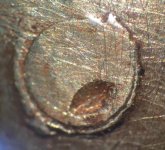jdgoguen
Aluminum
- Joined
- Jan 25, 2015
- Location
- Central Massachusetts, USA
I'm in the process of cleaning and reassembling my 10K which I've finally gotten into the basement (more about the acquisition and move later). There is excessive play in the compound that I would like to correct. It is due to the gap between the threads on the dial bushing and the large diameter section on the lead screw seen in this picture: I'm not sure how to dissemble the screw from the dial to add a bushing, or if there is some other way to make the adjustment. This lathe has the nice imperial/metric dials with internal gearing, and the crank handle attached differently from what's shown in the Ilion book or info I can find on line. The is a pin the looks like it's driven through the handle (see pic).
I'm not sure how to dissemble the screw from the dial to add a bushing, or if there is some other way to make the adjustment. This lathe has the nice imperial/metric dials with internal gearing, and the crank handle attached differently from what's shown in the Ilion book or info I can find on line. The is a pin the looks like it's driven through the handle (see pic). . There is a screw with a slot that goes all the way across holding the handle on rather the usual nut. The screw doesn't want to loosen with the pin in place, and I don't know if the pin goes through it. Do I just drive the pin out and force the screw?
. There is a screw with a slot that goes all the way across holding the handle on rather the usual nut. The screw doesn't want to loosen with the pin in place, and I don't know if the pin goes through it. Do I just drive the pin out and force the screw?
Thanks in advance for all replies,
Jon
 I'm not sure how to dissemble the screw from the dial to add a bushing, or if there is some other way to make the adjustment. This lathe has the nice imperial/metric dials with internal gearing, and the crank handle attached differently from what's shown in the Ilion book or info I can find on line. The is a pin the looks like it's driven through the handle (see pic).
I'm not sure how to dissemble the screw from the dial to add a bushing, or if there is some other way to make the adjustment. This lathe has the nice imperial/metric dials with internal gearing, and the crank handle attached differently from what's shown in the Ilion book or info I can find on line. The is a pin the looks like it's driven through the handle (see pic). . There is a screw with a slot that goes all the way across holding the handle on rather the usual nut. The screw doesn't want to loosen with the pin in place, and I don't know if the pin goes through it. Do I just drive the pin out and force the screw?
. There is a screw with a slot that goes all the way across holding the handle on rather the usual nut. The screw doesn't want to loosen with the pin in place, and I don't know if the pin goes through it. Do I just drive the pin out and force the screw?Thanks in advance for all replies,
Jon




